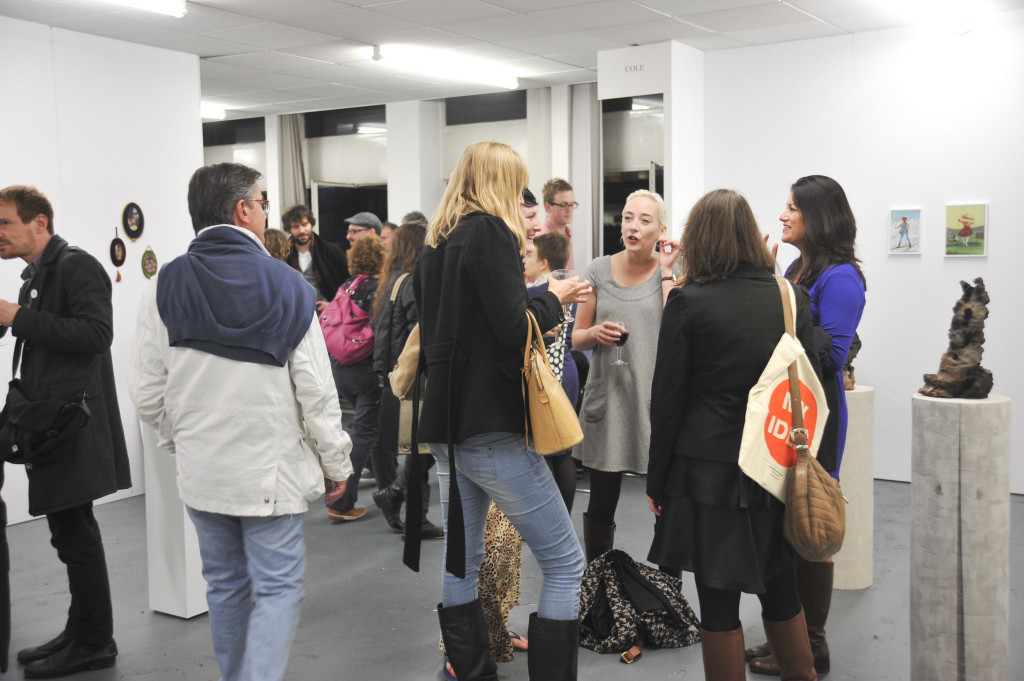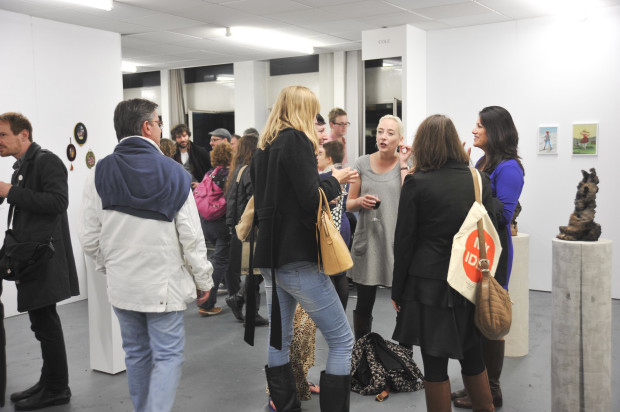
The Manchester Contemporary 2011

Now in its third year, The Manchester Contemporary has become an important fixture in the North West cultural calendar. Just a few weeks after the art fair juggernaut that is Frieze, ten invited commercial galleries from across the country gathered to each showcase a selection of artists they had chosen to exhibit at their respective stalls. Through their stalls, a wide range of original works such as drawings, sculptures, prints, paintings were available for the public to purchase and leave with. Housed a short distance from last years tent pitched in the heart of Spinningfields, The Manchester Contemporary took place in Quay House – a disused office block used by Punchdrunk in their production It Felt Like A Kiss for the 2009 Manchester International Festival.
The Jaguar parked outside the entrance and in the main foyer was a literal example of a main sponsor ‘parking’ their presence, so to speak. I visited on the final day to attend an insightful talk by Ceri Hand, who discussed the critical implications commercial galleries have. Hand spoke eloquently and honestly about the challenges that commercial ventures in the North face, an issue that adds weighty context to the main aims of the fair. Although seemingly smaller than last year’s edition, the overall set up was well executed and each gallery/project space used their allocated space intelligently. Ceri Hand Gallery (Liverpool) devoted its space to the unique sculptural configurations of Samantha Donnelly. Donnelly is an artist whose stock is rightfully in the ascent; she has a solo exhibition at the Cornerhouse in Manchester early next year.
Most exhibiting galleries chose to represent a small grouping of artists with Mermaid & Monster (Cardiff) and WORKS|PROJECTS (Bristol) worth noting. Andrew Bracey’s ReconFigure Paintings, a series of geometrically manipulated images of reproductions of old paintings, were exhibited by Castlefield Gallery (Manchester) and benefited from sole representation. The project spaces and talk programme, as well as the introduction of a Print Room, fleshed out the fair adding real depth. The small independent catering element was a nice touch. I’d like to imagine the small café section would have generated a fair few engaging conversations over the course of its few hours of operation.

So how do we judge the ‘success’ of an art fair? Subjective opinions on the quality of the content will always be present but personally, I am more interested in the issues that Ceri Hand raised in her talk. Based in the North West, The Manchester Contemporary is in an area were there is a limited art market. Frieze Art Fair is a juggernaut operating within a greater monster, London. The Manchester Contemporary should be lauded as an initiative that akin to the Ceri Hand Gallery, aims to generate a northern market activity via quality events. It is here that I want to mention the relationship between The Buy Art Fair and The Manchester Contemporary. Held a few floors below, The Buy Art Fair exhibited what could be labelled ‘decorative’ art by specialist galleries in a similar exhibiting structure. The two events seemed to overlap and blur by their proximity to another but kept their distance at all times, like you would to an ex-partner at a party after an acrimonious split.
Did the Buy Art Fair, hellishly busy when I popped in, increase sales for the Contemporary by introducing new visitors upstairs? Or were sales from The Manchester Contemporary primarily from existing collectors in the know? It would be interesting to see this information surface. Is a concurrent event useful in the quest to generate a larger market in the North West? Or will the divide become greater next year so that the sites are once again split? It will be interesting to see the structure of next years fair.
The Manchester Contemporary ran from Friday 28 – Sunday 30 October 2011.
This piece was published on Roves and Roams